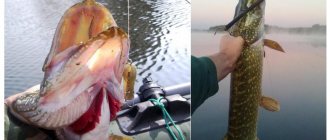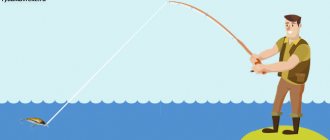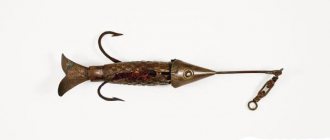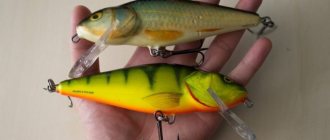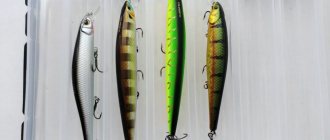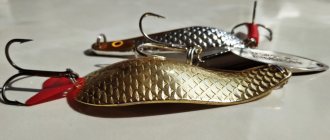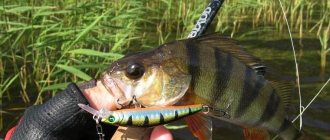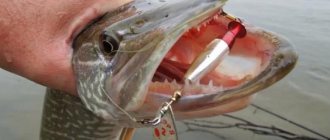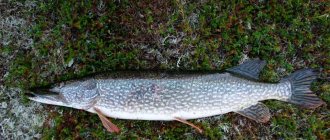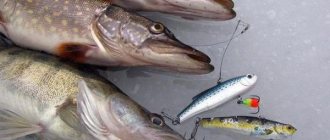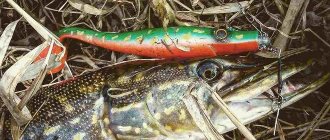Pike leads a characteristic way of life, which is often associated with so-called “strong places” - snags, thick grass, sow thistle, water lilies and rocky rubble. At such points, she not only hunts, but also digests the next victim, hiding behind a barrier from the strong current and unnecessary attention of her larger fellow tribesmen.
In difficult places, experienced fishermen, trying to catch pike with the least amount of lost bait, use various non-hooking hooks, both purchased and made with their own hands.
Koryazhnik is a place where non-hooking fishing rods are especially useful for catching pike and other predators.
Snags and other difficult places are the main habitat of not only pike, but also large perch - humpback salmon, pike perch, catfish. Therefore, unhooked fish often bring these predators as bycatch.
Advantages and disadvantages of non-hooking
The Krasnodar non-hooking spinner accepts twitching, jig, uniform and other types of animation.
The main advantage of non-hooking spoons is obvious - they allow spinning anglers to work the most difficult places - toad beds, oxbows overgrown with grass, snags in rivers, swamps.
Also, the equipment features of non-hooking baits allow the use of new variants of posting and animation - jigs, twitching and their variations, with virtually no risk of losing expensive and/or rare baits.
Some non-snagging baits are combinations of a spinner and a twister, a spinner and a silicone fish, and others. This also expands the possibilities of using non-hooking devices.
Types of non-hooking pike hooks used and equipment options
In spinning fishing when hunting for pike, the following are used:
- solid iron non-hooking lures - spinners and spinners, spinnerbaits, gliders, cicadas and other “pieces of iron”;
- non-hooking wobblers and their combinations, poppers;
- jig baits on offset hooks, as well as rigs with a bullet - Carolina and Texas, retractable leash on offsets and others.
Protection against snags is possible in the following ways:
- The very shape of the bait . The spinner or wobbler is made in such a way that the likelihood of snagging is minimal.
- The method of fastening and installation, as well as the type of hook . Offset hooks are used, or regular baits hidden in the body. Used on spinners, jigs, foam rubber, wobblers.
- Placement of the hook in the body of the bait . Hooks hidden (recessed) into the body of the bait; singles, doubles and trebles with protective mustaches or hook latches on magnets until the moment of bite.
Let us separately highlight gliders - baits for fishing on the surface, with hidden hooks.
Silicone in snags. The best non-snag
Date: January 25, 2021 | 926
When fishing with a spinning rod in general, and when fishing with soft silicone baits in particular, the angler very often encounters snags, hooks on the bottom and in the water column. On the one hand, the angler is annoyed by snagging and losing bait on snags. On the other hand, he himself often looks for such rubble or individual snags, because... near them there is often a concentration of fish and many bites occur. You have to find a balance between the desire to catch a predator and the risk of getting caught. In this article I want to talk about the use of various installations of silicone baits in snag conditions. Determine the best non-snags , installations that best pass through rubble and avoid snags.
Snags can be very different in their essence, composition, and geometry. The presence of a current in this place greatly affects the danger of snags.
It happens that a snag is just a separate flooded tree , and only its trunk part (the branches were broken off by time, they rotted, or they were carried away along with the broken off top).
Such an obstacle at the bottom is very common. Predatory fish, pike, pike perch, large perch, love to stand behind such a log, under it.
Finding individual sunken trees like these and jigging them is a good way to get bites and catches.
Such a simple snag in its essence, however, not every jig installation will go through without getting caught.
So, the anti-champion, the worst installation in terms of non-clinging, should be recognized as a hinged installation based on a double or triple hook.
Only if such equipment passes exactly over the tree, there will be no snag. If contact happens, the probability of a hook, in my opinion, is at least 70-80%.
The hinged mounting with a single open hook has a slightly better non-clinging indicator. Simply due to fewer hooks...
Even a regular jig head passes through such places better. Although, she sits down very often. And for now we are considering the simplest type of snag...
Jig heads of different shapes have different driftwood penetration. Some are better at overcoming obstacles - others are very bad at it. Sometimes a jig head in the shape of a boot or a fish head works well on snags.
Installing such snags with a jig head, on which wire or line protection against snags is installed, works somewhat better. Such tricks work with individual snags, but in the rubble, in dense snags, they are practically useless.
In practice, with close to 100% non-clinging properties, any installations on an offset hook can jump over such logs.
Now let's go through more complex snags and see how things are there.
A snag can be a whole tree or bush, with branches and root system.
These can be entire rubble of sunken trees and individual branches. Such snags can be clearings, flooded at the bottom of reservoirs, or rubble caused by rivers. The formation of snags is always different. This makes them dangerous and interesting.
The snag can only be located at the very bottom, some fragments may be located in the thickness, or even come to the surface. Such multi-level thick snags are hell for a spinner. But, if you get creative, good trophies often await you there.
So, in dense snags, and even in the current, all the above-mentioned installations are simply no good. All that remains is to evaluate the offset hook and installations using it.
There is one interesting opportunity to catch snags by using spaced rigs, such as a diverting leash and a drop shot. The idea here is that the streamlined sinker will go along the bottom, and the bait with a hook will go higher. The main thing here is to know the snag well. And this will work if the driftwood, the blockage, is at the very bottom, without rising to the middle layers. If you guess the distance from the load to the place where the leash or drop-shot hook is attached, then you can fish the area without any hooks at all and lure out a predator stuck in the support. All that remains is the risk of getting the weight stuck among the branches. But this risk is much less than getting caught on a hook. And also, weights, especially homemade ones, are much cheaper than bait with a hook.
Such a spaced rig, like the Carolina one, is not very good in snags, because bait on a separate leash often gets caught in snags.
Not very thick snags can be easily overcome by hinged mounting based on an offset hook.
But, in thicker debris, the Cheburashka sinker very often gets jammed. And now we are coming to the moment to name the best setup for fishing among snags. The title of best hook-free bait in the section of fishing with silicone baits goes to Texas equipment.
The bullet-shaped weight, sliding along the leash, practically does not jam among the branches, and the offset hook most reliably avoids snags.
In order for the offset hook to fit better and hide in the body of the bait, it is desirable that it have a longitudinal groove, a cut on the back. Many models of modern edibles have it. So, there are no problems with this.
Naturally, in especially dense multi-tiered rubble and snags, even installations on offset hooks, even Texas, do not completely protect against snags. But, when compared with all other equipment, the loss of bait with this method is minimal.
Also, it should be noted that the lighter the bullet weight used for Texas installation, the better it passes obstacles at the bottom, snags. The same rule applies to all other installations. Lighter load means fewer snags.
So, we can summarize. , Texas equipment is best suited . For bold fishing of single snags and flooded tree trunks, you can use it, or at least a hinged rig with an offset hook. Depending on the situation, you can bypass the snags using a drop-shot or a lead leash. And all other installations with open hooks are normal solutions for more or less clean areas of the bottom.
Share with your friends:
Categories: Edible fishing Tags: Snags, Installation, Unhooked, Lures
Non-snacking gliders and gliders for pike fishing: frog, Croatian egg and others
Gliders and gliders are definitely the best non-hooking gear for catching pike in the grass, which is close to the grass. Accordingly, they are used for surface fishing. In terms of colors, the situation is as follows - challenging colors work in muddy and cold water - yellow, tiger, red, black and yellow and the like. In light water during the summer they are more natural, although acidic ones should not be avoided.
Well-known and catchy ones include the following:
- Form factor Frog. Catching pike with an unhooked frog is always a fun and exciting activity (video below). But it’s worth mastering it without giving up at the first failures. Here it is important that all the stars come together - the bait, the reservoir, the mood of the fish and its attitude to the chosen animation. Specific Models:
- Swimming frog Kosadaka Target Frog. Silicone based bait. Weight 8.3 grams. Single offset hook. For overgrown toads, this is the best thing - it will pass through the grass, water lilies, and duckweed. It lures pike not only from the surface, but also from several meters, especially on a jerky, splashing retrieve. And what pike attacks directly on the surface are available to the spinning angler... Price from 200 rubles.
- Frog glider with legs from Kosadaka. Weight 10 grams. Silicone skirt on the double as an anti-catch. It works well on walking pike in water lilies, nettles, thistles, and also on chomping perch. Wiring - the easiest lazy twitch, stop-and-go, waves. Price from 250 rubles.
- Form factor Duck. In general, there are no special differences from frogs, except for the shape. But this factor in certain conditions can become decisive. Specific Models:
- Savage Gear 3D Hollow Duckling. A very original bait-toy for a child with removed hooks. With the rear tee removed, there is no snagging. When working correctly with the rod, it animates very coolly, either laying glides with smooth pulls with the rod, or imitating a wounded, disoriented duck with small jerks with the raised rod while simultaneously winding the cord. It collects even large pike well from long distances. Price from 600 rubles.
- Form factor Croatian egg. Specific Models:
- Bumble Lure. One of the most famous "eggs". Material: balsa. Lightweight, but catchy, extremely catchy and expensive. Works on duckweed and other vegetation directly on the surface. Popper wiring, pulls, gurgling uniformity. Prices from 200 rubles and above at flea markets, new ones can cost up to 1000 rubles and above.
It should be taken into account that there is a large number of China among non-catching gliders and gliders, but this does not mean that it will not catch. It's worth experimenting and believing in yourself.
Fishing with unhooked hooks
Catching pike with unhooked hooks requires a special approach, so you need to know how to fish with such gear.
Below are some tips that will help you when fishing without hooks:
- You need to start fishing from places where there are a lot of thickets and all kinds of snags. Pike often hide there, and besides, the hookless fishnet is designed specifically for such places;
- You should not make a lot of noise, as the pike, which hides in the thickets, is very easy to scare off; • Wiring must be done carefully, without sudden movements;
- You should not carry out the search directly to the places where the thickets are located; you need to find a clear place in the middle of the thickets and throw there;
- It is necessary to ensure good play of the bait during free fall;
- If fishing is carried out in places where there is mud, then you need to take the most non-clinging non-clinging ones, since it very quickly clogs the hook with its thin pieces of algae.
- It is better to fish with non-catching baits using different types of wiring, this will provide a good game to attract pike;
- You need to check the non-hook to see what type of wiring is best suited for it. To do this, you can do smooth or sharp pull-ups with a spinning rod;
What to choose from wobblers and how to equip a regular working bait
Losing a catchy and expensive wobbler is doubly unpleasant. Not only are they expensive, but they are often very rare. That’s why almost every spinner tries to protect his favorite wobbler from breaking.
Recommended non-hooking wobblers for pike:
- Rapala Weedless Shad. 80 mm, 16 grams. Another unique and easy-to-catch hook from Rapala. Equipped with a clearly fixed hook - single hook. Passes the strongest places. It swings its sides very beautifully both during the retrieve and during pauses - while slowly sinking. Works in the bushes. Price 550+ rubles.
- Wobbler AmniHook. 66 mm, 8 grams. Equipped with offset from Ovner. Multi-component bait, consists of 8 baits in one. Soft foam and silicone, 4 pieces each. The first option (PSV foam) is used for fishing from the surface (water lilies, nettles, other grass, rafting on the river in areas where other baits cannot be thrown). The second (silicone baits) is used for fishing in the middle layers of the reservoir in strong places. Fishing places - from a quiet pond to a rapid. There are kits from 1000 to 5000 rubles.
It should be noted that not many high-quality and catchy wobblers come off the assembly line; fortunately, almost any ordinary wobbler can be turned into a non-hooking wobbler on your own.
Hooks with protection
Ovner, Jamakastu and other manufacturers have such hooks. These tees or non-hooking doubles can be used to retrofit any wobbler. Similar hooks can also be equipped with vibrators and turntables.
Loose fittings
The fittings (rings, hooks) are selected in such a way that they become a “thin spot”, that is, they unbend first, which allows for minimal losses when hooking.
For example, hooks from the ST Owner series are good.
Wobbler wire protection
The type is the same as in the video, but any man with a vice and straight hands can bend such a mustache from a rigid wire.
Equipment for jig non-snagging lures for pike
It is easier to make a non-hooking jig bait for pike with your own hands by using appropriate rigging methods, hooks, jig heads and types of silicone.
The options are as follows:
- use of offset hooks;
- the use of anti-hook jig heads;
- options for equipping conventional hooks accordingly;
- options for non-snacking jig rigs.
Equipping baits with offset hooks
The most commonly used equipment option due to its convenience and simplicity. Most often it is used in conjunction with a “Cheburashka” load. Equipment options:
Offset jig bait with Cheburashka
Anti-snap jig heads
The highest quality ones are from Decoy. Equipping with jigs is carried out similarly to the previous option, but on a rigid coupling.
Decoy jig head
Non-hook collar
Equipped with regular hooks
You can use ordinary singles and doubles, but hidden inside the bait. Often used with worm-slug type baits.
Profile jig equipment
Equipment designed for jig fishing in strong places. Texas, Carolina, lead and drop-shot rigs are the most famous and used.
The best non-hooking baits for pike and fishing techniques in grass and water lilies
The specific habitat of pike is associated with the search for shelters to lie in wait for prey. In reservoirs, natural shelters include depressions at the bottom, thickets of aquatic vegetation, and snags in isolated areas of the water area. It is often not possible to catch promising predator sites with artificial bait due to frequent snags on obstacles. This is where non-hooking baits become favorites in fishing - lures with modifications that prevent snags and increase their permeability.
The properties described above are achieved by methods that hide the tips of the hooks when retrieving and expose them when biting. There are two principles for creating cross-country ability. The first is based on the use of soft baits, the bodies of which make it possible to hide the hook in them. When the predator’s mouth squeezes such a bait, the tip of the hook is released and pierces the soft tissue of the fish’s mouth.
The second principle is based on covering the tip with an elastic wire, which, when pressed by the jaws of the fish, moves away from the sting and releases the hook for hooking in the predator’s mouth.
Important! Non-hooking lures are used by anglers for spinning fishing and serve as a tool for fishing water bodies overgrown with algae and snags in promising pike areas.
Depending on the fishing conditions, a type of bait with high permeability is selected based on its shape, size, material and game characteristics. It is rational to use non-clinging spoons in the grass in shallow waters and coastal thickets adjacent to dumps and edges of free water areas. Jig baits made of silicone and foam rubber bases on offset hooks are more effective when used in snags at depths and on the bottom with dead wood from small branches and fallen vegetation.
When forming equipment with a non-hook for jig fishing, in addition to using an offset hook, you need to use a sinker in the form of a bullet or a smooth cone to minimize the possibility of the equipment getting caught in obstacles. For fishing in water lilies and water lotus, the greatest success is achieved by popper-type wobblers and Croatian egg-type gliders. In sparse vegetation, they are successfully caught using ordinary oscillating spoons, with small silicone worms or vibrating tails attached to the tees, which hide the points of the hooks in their soft but elastic body, thereby fighting off all obstacles in the form of blades of grass and algae stems along the way.
Important! Non-hooking lures for pike are not characterized by active independent play due to the limited space when using them and will require the angler to perform animation actions in their most energetic forms of manifestation, which should be taken into account when selecting a rod for fishing with such lures.
We will present the 10 best non-hooking spinners for pike in the form of a rating, which will give an idea of the effectiveness of the accessory and its catchability, as well as price rank and availability for sale. These types of spinners, without a doubt, are worth purchasing for the arsenal of a pike hunting enthusiast, because summer fishing strategies without fishing overgrown areas of the reservoir cannot be considered complete. Well, this kind of bait will help you successfully and comfortably fish promising places.
We confidently put forward the representative from Blue Fox, the Lucius Weedless . The manufacturer produces two varieties of spinners, a lighter one, 9 cm and 27 g, and a powerful one, 12 cm and 36 g. The durability of the coating, the reliability of the hook and the well-functioning pressure of the protective mustache will leave this model among your fishing favorites for a long time. Due to the mass, the bait's long-range and ram-type maneuverability are ensured. The price is average.
The domestic company Russian Spinner, with its brainchild Atom-N, is quite worthy of the second line. The extraordinary play of the spoon and convenient standard sizes of 7-10-18 grams provide ample opportunities for using the spoon for various fishing conditions. The budget price parameter is also in favor of this best non-hooking line for pike.
XPS Stomper Weedless , with its creative acoustic qualities, firmly holds third place. Even if its price is high, but the high-quality fastening of the hook assembly - a protective mustache and the indelible surface more than pay for the investment in the long-term use of the accessory.
Fourth place went to the classic unhooked one - Kuusamo Viiksi . The advantages of this tool are the stable amplitude of oscillations at different wiring speeds. A powerful hook made of thick wire, with a rigid protective bracket, knocks off both hard snags and dense vegetation. The disadvantage is that it can only be used in shallow areas of the reservoir. Price – budget rank.
Gator Plain non-snaking spinner rounds out the top five in the rating. Designed for fast retrieves in cramped conditions and having the ability to equip the body and hook with additional elements for replanting baits. This bait works in both deep and shallow waters. The thing is expensive, but catchable in the summer months, when the heat makes the predator passive and capricious in its preferences for prey.
Sixth line for Johnson Silver Minnow . A classic universal non-snacking line for shallow waters with dense growth. Slow oscillating movements, even with accelerated reeling, allow you to lure a low-active pike out of an ambush. The catches are dominated by medium-sized predators. Sometimes the quality of soldering of hooks and protective wires suffers, which requires constant checks of their condition. Otherwise, it’s a budget-friendly item that’s popular among beginner pikemen.
The seventh in rank is the Croatian egg from KIRA Fishing . A glider with a durable paint coating, a balanced stroke during dynamic pulls and a reliable, monolithic hook fastening. The non-hooking wobbler is available in a wide variety of colors. The best option for catching catfish is in toad beds. The disadvantages are the specificity of the wiring technique, which limits the widespread use of the popper by spinning fishing beginners.
Eighth place goes to Marsh 012 Mystic . Miniature oscillating spinner with a protective whisker. With a low weight it has high tunneling qualities. The catches bring a small pike, but with enviable stability. Cost in average parameters. The most catchy fish are in tiger coloring with green shades.
A little lower in the top is the Live Forage . An unusual holographic coating on the body and a reinforced V-shaped breaker are the main advantages of this tool. Disadvantages - the primitiveness of your own game and the required high skills in animation techniques. Average price factor.
The Acara Aver model, popular among beginners, closes the top ten . For fishing in coastal thickets, seven-centimeter spinners of yellow-green colors are used. The quality of the spinners is mediocre, but its own active animation smooths out these nuances. A low-budget bait can easily be considered a consumable by a fisherman, especially when fishing in promising snags.
Non-clinging spinners can be made at home by adapting a classic spinner for this purpose.
Important! To produce the product, you only need a soldering iron and pliers. Additional accessories include a powerful single hook with an extended fore-end and a thick guitar string.
The treble hook and the winding ring for attaching it are removed from the factory spinner. A single hook is soldered into the body of the spinner from its concave part, with the calculation of the projection of the forend with the sting beyond the edge of the body of the product being 1.5 - 2 centimeters. Then cut a piece of string to a size 1/3 larger than the spoon itself with the hook soldered to it. A piece of string is soldered in the front part of the spinner body on the same hook mounting line. After soldering, the string is bent so that it rests on top of the hook tip, creating one center line with it.
The rigidity of the string material allows it to maintain its given shape, and with light pressure it can slightly deform, releasing the sting. This principle helps to avoid snags on the wires with minor resistance, but with more active deformations - and this is mainly the bite of a predator - to release the tip of the hook. With the help of these simple modifications, the spoon significantly changes its purpose and becomes a full-fledged non-hooking spinner for pike.
By the way, if you are a fan of experiments, then
Unhooked spinners for pike
As mentioned earlier, the industry practically does not produce high-quality spinners with protection against snagging. But it’s easy to make a rotating spinner without hooking with your own hands.
Spinner with anchor with protection mustache:
Offset and twister equipment:
How to make a non-hooking hook for a pike with your own hands:
Tips for using non-snagging lures
It should be understood that no bait, even the highest quality, guarantees a catch if you do not have the proper knowledge and understanding of how to use it.
So, our recommendations:
- A non-hooking bait or equipment does not give one hundred percent guarantees, so there is a fight for madness. You should not throw bait into very difficult places.
- When re-equipping spinners and, especially, wobblers for non-hooking, you need to take into account that the game of baits may change.
- The hook should be sharper and more biting than when fishing with conventional bait.
- The stronger the fishing spot, the stronger the protection wire.
- The selection of a specific bait depends on the fishing conditions and the intended catch, as in normal conditions.
The most catchy colors of “Kuusamo”
It is impossible to unequivocally answer the question of which colors of Kuusamo spinners are the most catchy. When choosing a color, you need to focus on a number of indicators:
- water clarity;
- depth at the fishing site;
- illumination;
- predator activity at the time of fishing.
The photo shows the most catchy colors of “Kuusamo”.
In muddy river water, acid-colored spinners or dark lures interspersed with bright elements will work better. Such models are found in almost every line of Kuusamo.
Nice colors
In clear lake water, pike prefer to peck at models of natural colors that remind them of their usual prey. For each body of water, the angler has to choose its own color. Silver and golden colors are considered the most universal.
With decorative stone
Bright lures help out the spinning angler when fishing at great depths and in cloudy weather. On clear days, dark and natural colors work better. The more active the predator, the more noticeable the spinner should be.
Many colors
